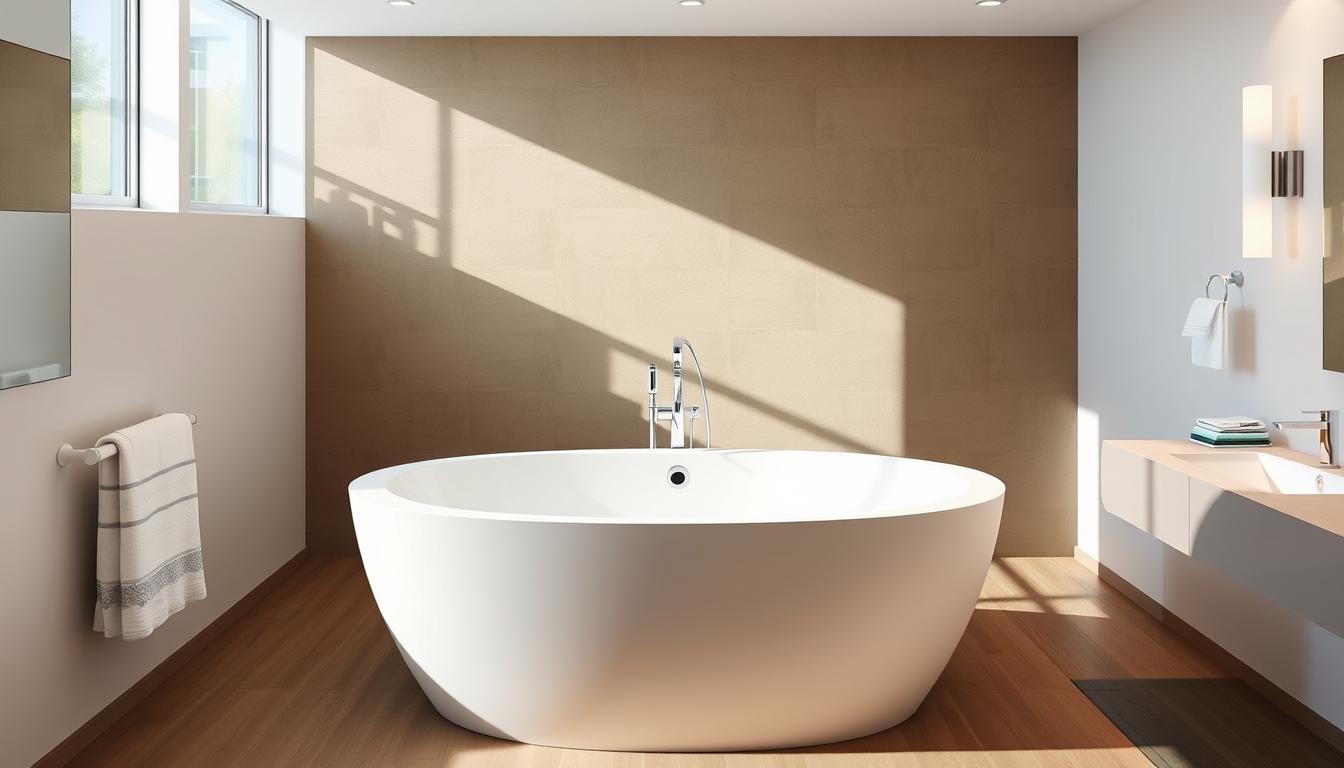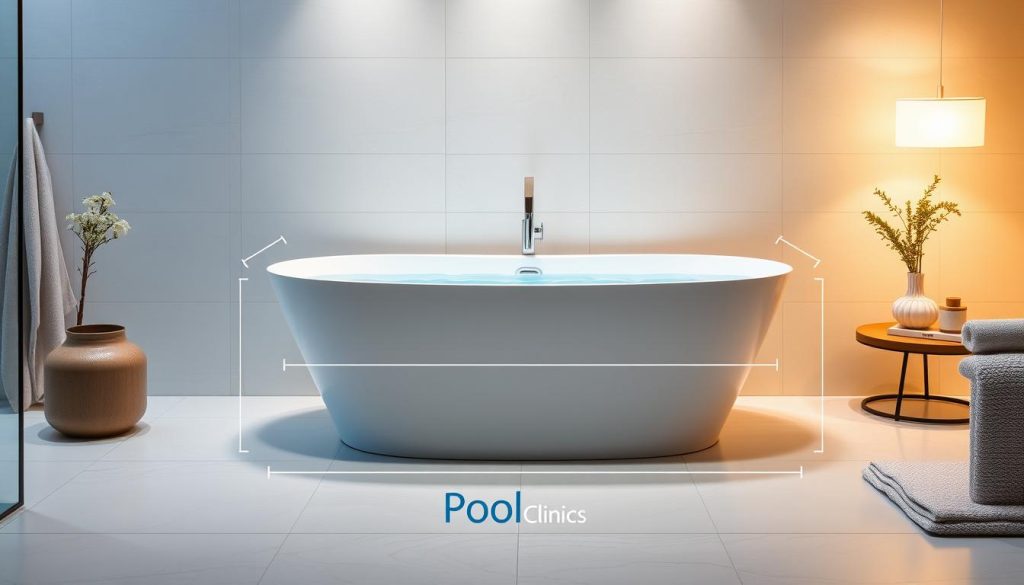
Ever wonder about your bathtub’s capacity during a relaxing soak? It’s a common question that affects water usage and environmental impact. The answer isn’t simple, as bathtub volume varies based on several factors.
Knowing standard bathtub size and capacity is crucial for water consumption decisions. It also helps ensure your bathroom’s structural integrity. Let’s explore the factors that influence a tub’s water volume.
This guide will give you the knowledge you need about bathtub capacity. It’s useful for homeowners looking to save water or anyone curious about bathroom mechanics. Let’s uncover the secrets of bathtub capacity together!
Key Takeaways
- A standard U.S. bathtub holds approximately 42 gallons (159 liters) of water.
- Bathtub sizes can vary, with smaller tubs holding around 40 gallons (150 liters) and larger tubs accommodating up to 110 gallons (416 liters).
- The bathtub volume is crucial for understanding water usage and the strain it puts on your floor, as a gallon of water weighs roughly 8 pounds.
- Factors such as bathtub dimensions, shape, and displacement caused by a person’s body can affect the actual volume of water a tub can hold.
- Knowing your bathtub’s capacity can help you make informed decisions about water conservation and energy efficiency in your home.
Understanding Bathtub Sizes and Capacities
Choosing the right bathtub requires knowledge of average dimensions and water capacity. Common measurements can guide your decision, despite the lack of universal standards.
Your bathroom’s layout and personal preferences will influence the ideal bathtub size. Consider these factors when selecting your perfect tub.

Standard Bathtub Sizes
The typical alcove bath measures 60 inches long, 30 inches wide, and 14 to 16 inches high. Other bathtub types have different dimensions.
Soaking tubs are 60 to 72 inches long with a 14-inch or deeper depth. Oversized tubs exceed 70 inches in length and 16 inches in depth.
Freestanding tubs range from 55 to 72 inches long and 27 to 32 inches wide. Their water depth is 15 to 20 inches.
- Soaking tubs generally range between 60 to 72 inches long with a depth of 14 inches or more.
- Oversized tubs are typically over 70 inches long and have a soaking depth of 16 inches or more.
- Freestanding bathtubs can range from 55 to 72 inches in length, 27 to 32 inches wide, and have a water depth of 15 to 20 inches.
- Alcove bathtubs are usually 60 inches long, 30 inches wide, with a water depth of 16 inches.
- Drop-in bathtubs typically measure 60 inches in length, 30 inches wide, with a water depth of 16 inches.
- Corner bathtubs are usually 60 inches by 60 inches with a water depth of 20 inches.
- Walk-in bathtubs are around 60 inches long, 30 inches wide, and have a water depth of approximately 30 inches.
Factors Affecting Bathtub Capacity
Bathtub style and type influence water capacity. Different tubs hold varying amounts of water and have different fill times.
| Bathtub Type | Water Capacity (Gallons) | Fill Time (Minutes) |
|---|---|---|
| Standard Bathtub | 80 | 5-7 |
| Small Alcove Bathtub | 40 | 3-5 |
| Freestanding Bathtub | 90-100 | 7-15 |
| Corner Bathtub | 40-60 | 4-6 |
| Drop-in Bathtub | 60-110 | 5-10 |
| Non-traditional Designs | 70-120 | 6-12 |
Bathtub material affects capacity and durability. Each material has unique properties and benefits.
Acrylic tubs are light, easy to install, and last about 15 years. Fiberglass tubs are budget-friendly but prone to scratches.
Cast iron tubs require extra support but are long-lasting. Copper tubs resist rust and mildew but cost more.
- Acrylic bathtubs are lightweight, easy to install, and budget-friendly, lasting about 15 years.
- Fiberglass bathtubs, also budget-friendly and easily installed, are prone to scratches and cracks but more durable than acrylic.
- Cast iron tubs are a long-term investment with less maintenance but require extra support due to their weight.
- Copper bathtubs develop a multicolored patina finish, are rust-proof, mildew-resistant, and durable, requiring a significant upfront investment.
- Stone resin bathtubs are a blend of resin and crushed natural stone, resisting stains, mildew, scratches, and cracks.
Calculating Liters in a Bathtub
Converting measurements and calculating volume is key to determining bathtub capacity. We’ll explore how to convert gallons to liters and calculate bathtub volume. This will help answer, “How many liters are in a bathtub?”
Converting Gallons to Liters
To convert gallons to liters, multiply the number of gallons by 3.785. Let’s use a 42-gallon bathtub as an example:
42 gallons x 3.785 = 158.97 liters
A 42-gallon bathtub holds about 159 liters of water. The actual capacity may be lower when a person enters the tub.
Formula for Calculating Bathtub Volume
Use this formula to calculate bathtub volume:
length x width x depth (in feet) x 7.48 = volume (in gallons)
Multiply the result by 3.785 to get the volume in liters. Let’s look at an example:
- Length of the bathtub: 5 feet
- Width of the bathtub: 2.5 feet
- Depth of the bathtub: 1.5 feet
Using the formula, we calculate the volume in gallons:
5 x 2.5 x 1.5 x 7.48 = 140.25 gallons
Now, let’s convert this volume to liters:
140.25 gallons x 3.785 = 530.85 liters
This bathtub can hold about 531 liters of water. Understanding bathtub capacity helps with water usage and energy consumption considerations.
Average Bathtub Capacity and Water Usage
Understanding bathtub capacity helps us make smart water choices. It’s crucial for proper water heater sizing. Let’s explore average bathtub volumes and typical bath water usage.
Average Bathtub Capacity in Liters
A standard bathtub holds about 302 liters (80 gallons) of water. Smaller tubs for kids or tight spaces contain around 150 liters (40 gallons). Luxury bathtubs can fit up to 410 liters (110 gallons).
Variations in Bathtub Capacities
Bathtub capacities vary based on type and design. Here’s a quick look at different bathtub styles and their typical water capacities:
| Bathtub Type | Capacity Range (Liters) | Capacity Range (Gallons) |
|---|---|---|
| Standard Bathtub | 302 | 80 |
| Small Bathtub | 150 | 40 |
| Large Bathtub | 378-410 | 100-110 |
| Freestanding Bathtub | 340-378 | 90-100 |
| Corner Bathtub | 150-227 | 40-60 |
| Acrylic Drop-in Bathtub | 227-302 | 60-80 |
| Shower/Tub Combo | 227-416 | 60-110 |
Water Usage Considerations
A typical bath uses between 132-189 liters (35-50 gallons) of water. This is more than a 10-minute shower, which uses about 94 liters (25 gallons).
Ensure your water heater can handle your bathing needs. Small homes often have 114-136 liter (30-36 gallon) heaters. Larger households may need 151-227 liter (40-60 gallon) heaters for baths and showers.
By knowing bathtub capacity and water use, we can make eco-friendly choices. This knowledge helps us choose the right water heater for our homes.
Conclusion
Understanding bathtub capacity in liters is vital for efficient water use. It ensures our floors can support a filled tub’s weight. Knowing standard bathtub sizes helps us make smart choices about bathing habits.
Compact clawfoot slipper tubs hold 150 to 227 liters. Larger Japanese soaking tubs can contain 454 to 1,136 liters. To calculate water volume, use length x width x depth.
Remember, 1 gallon equals about 3.785 liters. Our bodies displace water when we enter the tub. This affects the actual amount needed for a relaxing bath.
Being aware of our water usage allows for luxurious soaks while staying responsible. Next time you prepare a bath, consider the science behind this simple pleasure. Enjoy your warm, soothing bathtub with just the right amount of water.







